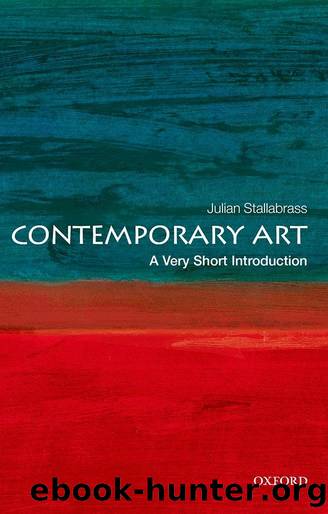Contemporary Art by Julian Stallabrass

Author:Julian Stallabrass [Stallabrass, Julian]
Language: eng
Format: epub
ISBN: 9780192561282
Publisher: OUP Oxford
Published: 2020-10-15T00:00:00+00:00
16. Andreas Gursky, Amazon, 2017.
Chapter 4
Uses and prices of art
As long ago as 1968, in a lecture given at the Museum of Modern Art in New York, the critic Leo Steinberg argued that avant-garde art, newly Americanized, was coming into close alignment with big money: modernism was a speculative stock, and quality had become âmarket attractivenessâ. He predicted that before long âmutual funds would appear based on securities in the form of pictures held in bank vaultsâ. Back then, contemporary art was still settling into its accommodation with money as the market outgrew its old condition as a tiny and specialist area, and there was brief wonder at the resulting change of scene. This passage, read over fifty years on, has the peculiar quality of being both surprising and familiar. In the long settling that followed, the association of art and money was less remarked upon, and a shyness crept over dealers and critics alike, as if the relation, too clearly spelt out, was dangerous. Those artists and critics who had the temerity to highlight it (such as Lee Lozano with the embarrassing and revealing offer of free money to her studio visitors) ran the risk of being thought vulgar, materialist, and overliteral.
Things have switched back again now. Since the early 2000s, strong modernizing forces in the contemporary art market brought money back into clear view and unabashed discussion. We will fix upon these forces throughout this chapter, but for now we should look at the system as it was, to understand the current contrast. Both making and selling are unusually controlled in the contemporary art market. Dealers may sign exclusive contracts with artists who are then encouraged or instructed to produce particular kinds, sizes, and numbers of work: how often has one seen in commercial galleries decorative and wall-bound spin-offs of some apparently recalcitrant anti-commercial installation? For obvious reasons, these urgings usually remain secret. Buyers are vetted for their commitment to collecting, since it can be dangerous to an artistâs reputation or even to the market as a whole to have a sudden and unexpected sale of work. There is less regulation in the so-called âsecondary marketâ of the auction houses, but even there the market is hardly free. Aside from scandals about systematic price-fixing, reserve prices are set below which works will not sell, the house itself quietly buys in works that fail to reach an acceptable price, and bidding is manipulated by collectors, dealers, and speculators. One innovation, much used recently, has been the guarantee, under which a would-be buyer secretly agrees to purchase a work at a set price should the auction bids not exceed it. Since both the agreement and the price remain secret, it is an insider manipulation of an apparently open market.
When art was produced using craft methods, the supply of any artistâs work was unavoidably restricted, and if demand for that work was high, then prices rose. There are still many artists who create value through the expenditure of large amounts of manual labour (their own or more often their assistantsâ) on unreproducible objects.
Download
This site does not store any files on its server. We only index and link to content provided by other sites. Please contact the content providers to delete copyright contents if any and email us, we'll remove relevant links or contents immediately.
Wonder by R.J. Palacio(8430)
Mastering Adobe Animate 2023 - Third Edition by Joseph Labrecque(3706)
Unlabel: Selling You Without Selling Out by Marc Ecko(3574)
Ogilvy on Advertising by David Ogilvy(3482)
Hidden Persuasion: 33 psychological influence techniques in advertising by Marc Andrews & Matthijs van Leeuwen & Rick van Baaren(3454)
Drawing Cutting Edge Anatomy by Christopher Hart(3437)
The Pixar Touch by David A. Price(3344)
POP by Steven Heller(3297)
The Code Book by Simon Singh(3055)
The Art of War Visualized by Jessica Hagy(2932)
Slugfest by Reed Tucker(2923)
The Curated Closet by Anuschka Rees(2896)
Rapid Viz: A New Method for the Rapid Visualization of Ideas by Kurt Hanks & Larry Belliston(2813)
Stacked Decks by The Rotenberg Collection(2796)
365 Days of Wonder by R.J. Palacio(2737)
The Wardrobe Wakeup by Lois Joy Johnson(2717)
Keep Going by Austin Kleon(2681)
Tattoo Art by Doralba Picerno(2582)
Tell Me More by Kelly Corrigan(2579)
